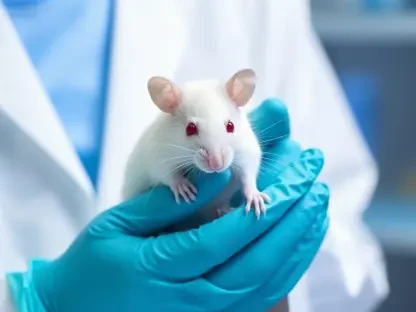In a world increasingly threatened by antibiotic resistance, the emergence of Klebsiella pneumoniae as a major health hazard has sounded alarms across medical communities globally, highlighting the urgent need for innovative solutions. This bacterial pathogen, notorious for causing severe hospital-acquired infections, has developed a cunning ability to neutralize β-lactam antibiotics, which have long been a cornerstone of bacterial infection treatment. Through the production of β-lactamase enzymes, this bacterium renders these vital drugs ineffective, creating a pressing public health crisis. A groundbreaking study published in Molecular Diversity offers a glimmer of hope by exploring innovative inhibitors designed to counteract this resistance, potentially transforming the landscape of treatment options. The urgency to address such resistance cannot be overstated, as it directly contributes to heightened morbidity, mortality, and spiraling healthcare costs, placing it among the top global health threats identified by leading organizations like the World Health Organization.
The Threat of Antibiotic Resistance
Urgency and Global Impact
The escalating challenge of antibiotic resistance has positioned Klebsiella pneumoniae as a critical adversary in modern medicine, exacerbating illness, death rates, and financial burdens on healthcare systems worldwide. This pathogen’s ability to resist multiple drugs has made it a focal point in the fight against bacterial infections, particularly in hospital settings where vulnerable patients are at high risk. The World Health Organization has consistently highlighted antibiotic resistance as a top-tier global health threat, urging immediate action to curb its devastating effects. The rise in resistant strains like Klebsiella pneumoniae not only complicates treatment protocols but also increases the likelihood of prolonged hospital stays and secondary complications. This situation demands innovative solutions that can outpace the rapid evolution of bacterial defenses, ensuring that effective therapies remain available for those in dire need of medical intervention.
Beyond the immediate clinical challenges, the broader societal impact of antibiotic resistance driven by pathogens such as Klebsiella pneumoniae reveals a stark reality of strained public health resources and compromised patient safety. The economic toll is staggering, with billions spent annually on managing resistant infections that could have been prevented or treated more effectively with advanced drugs. This crisis transcends borders, affecting both developed and developing nations, and underscores the need for a unified global response. International health bodies advocate for heightened surveillance, improved infection control measures, and accelerated research into novel treatments. Without such efforts, the ability to manage even routine infections could diminish, leading to a future where once-treatable conditions become life-threatening. The urgency to innovate in this space has never been more apparent, as every delay amplifies the risk to global health security.
Historical Challenges with β-Lactam Antibiotics
For decades, β-lactam antibiotics, including penicillins and cephalosporins, have served as a bedrock in the treatment of bacterial infections, saving countless lives with their potent efficacy. Their mechanism of action, which disrupts bacterial cell wall synthesis, made them indispensable in clinical settings. However, the tide turned as bacteria like Klebsiella pneumoniae evolved to produce β-lactamase enzymes capable of breaking down these drugs, rendering them powerless. This resistance mechanism has progressively eroded the utility of a once-reliable class of antibiotics, leaving medical professionals grappling with limited options for effective treatment. The historical reliance on β-lactams now stands as a reminder of how quickly bacterial adaptation can outstrip pharmaceutical advancements, pushing the need for continuous innovation to the forefront of medical research.
This ongoing battle between antibiotic development and bacterial resistance illustrates a relentless cycle where each new drug is eventually met with a counter-response from pathogens such as Klebsiella pneumoniae. Over time, the introduction of successive generations of β-lactam antibiotics has been met with increasingly sophisticated resistance mechanisms, highlighting a critical gap in long-term solutions. The historical context of this struggle reveals not only the ingenuity of bacterial evolution but also the shortcomings of traditional drug discovery pipelines that often fail to anticipate such rapid adaptations. As resistance continues to spread, it becomes evident that merely modifying existing antibiotics is insufficient. Instead, a paradigm shift toward novel methodologies is essential to regain control over infections that threaten to spiral beyond current medical capabilities, emphasizing the importance of exploring uncharted therapeutic territories.
Innovative Drug Discovery Approaches
Fragment-Based Drug Discovery (FBDD)
In the quest to overcome antibiotic resistance, fragment-based drug discovery (FBDD) emerges as a revolutionary strategy that diverges significantly from traditional high-throughput screening methods in pharmaceutical research. Unlike conventional approaches that test large, complex molecules for efficacy, FBDD focuses on smaller chemical fragments that can bind to specific biological targets, such as the β-lactamase enzymes produced by Klebsiella pneumoniae. These fragments, though initially weak in binding, offer a unique starting point for developing potent inhibitors through systematic optimization. The beauty of this method lies in its ability to uncover novel chemical scaffolds that might be overlooked by older, less precise techniques, providing a fresh arsenal against resistant bacteria. This innovative tactic holds the promise of revitalizing treatments that have been sidelined by evolving pathogens, marking a significant leap forward in drug discovery.
The potential of FBDD extends beyond merely identifying new compounds; it reshapes the very foundation of how effective inhibitors are conceptualized and developed to combat resistance in bacteria like Klebsiella pneumoniae. By starting with small, simple fragments, researchers can explore a vast chemical space with greater efficiency, piecing together molecular structures that precisely target the active sites of β-lactamase enzymes. This approach not only enhances the likelihood of discovering unique inhibitors but also reduces the risk of off-target effects that often plague larger molecules. Furthermore, the adaptability of FBDD allows for rapid iterations in design, enabling scientists to refine fragments into highly effective drugs tailored to specific resistance mechanisms. As this methodology gains traction, it stands to redefine the landscape of antibiotic development, offering a sustainable path to address one of the most pressing challenges in modern healthcare.
Methodological Precision in Research
The meticulous research process behind identifying novel β-lactamase inhibitors for Klebsiella pneumoniae showcases an impressive blend of computational and experimental techniques designed to maximize efficiency and accuracy. Initially, a diverse library of chemical fragments was assembled, varying in size and functionality to ensure a broad spectrum of potential binders to the target enzyme. Advanced computational modeling played a crucial role in predicting how these fragments might interact with the β-lactamase active site, narrowing down candidates for further testing. This predictive approach was complemented by in vitro assays that experimentally confirmed binding affinity and inhibitory potential, ensuring that only the most promising fragments advanced. Such a dual methodology highlights the precision required in modern drug discovery, where theoretical insights must align with practical outcomes to push forward viable therapeutic solutions.
Following the initial screening, the research entered a critical phase known as hit validation, where selected fragments underwent rigorous testing to confirm their selectivity for the β-lactamase enzyme produced by Klebsiella pneumoniae. This step was vital to avoid unintended interactions with bacterial metabolism that could compromise safety or efficacy. Potency assessments further refined the selection, focusing on fragments with the strongest inhibitory effects. Subsequent optimization through medicinal chemistry techniques allowed for structural modifications to enhance therapeutic properties while minimizing toxicity. This iterative cycle of validation and refinement underscores the painstaking effort required to transform initial hits into drug candidates capable of restoring the effectiveness of β-lactam antibiotics. The disciplined approach not only validates the potential of these inhibitors but also sets a benchmark for future studies aiming to tackle antibiotic resistance with similar rigor.
Implications and Future Directions
Clinical and Public Health Benefits
The discovery of novel β-lactamase inhibitors targeting Klebsiella pneumoniae holds transformative potential for clinical outcomes, particularly in hospital environments where resistant infections pose a significant threat to patient recovery. These inhibitors could effectively restore the power of β-lactam antibiotics, offering a lifeline to individuals battling severe, drug-resistant infections often contracted in healthcare settings. Improved treatment options would likely reduce the duration of hospital stays, decrease the incidence of complications, and ultimately save lives by addressing infections that current therapies fail to control. This advancement represents a critical step toward reclaiming ground lost to resistance, ensuring that medical professionals have reliable tools to manage even the most stubborn bacterial pathogens, thereby enhancing the standard of care across diverse patient populations.
From a broader public health perspective, the successful development of these inhibitors could significantly alleviate the strain on healthcare systems burdened by the rising tide of antibiotic resistance fueled by pathogens like Klebsiella pneumoniae. The economic impact of resistant infections, which includes billions in additional costs for extended treatments and infection control measures, could be mitigated through more effective therapies. Additionally, reducing the prevalence of such infections would lessen the need for resource-intensive interventions, freeing up capacity for other pressing health concerns. This ripple effect could strengthen global health resilience, particularly in regions where access to advanced treatments is limited. As these inhibitors move closer to clinical application, they offer a beacon of hope for a future where the devastating consequences of resistance are substantially diminished, safeguarding community health on a worldwide scale.
Revitalizing Antibiotic Development
The success of fragment-based drug discovery in identifying inhibitors for Klebsiella pneumoniae serves as a powerful catalyst for revitalizing the stagnant field of antibiotic development, which has struggled to keep pace with bacterial resistance. Traditional drug discovery pipelines, often hindered by high costs and low success rates, can draw inspiration from the efficiency and precision of FBDD, which bypasses many conventional limitations by starting with smaller, more manageable chemical fragments. This approach not only accelerates the identification of viable compounds but also encourages pharmaceutical companies to reinvest in antibiotic research, a field often deemed unprofitable compared to other therapeutic areas. By demonstrating tangible progress, this research paves the way for renewed focus on creating drugs that address urgent unmet needs in infection control, potentially reshaping industry priorities.
Moreover, the emphasis on interdisciplinary collaboration in this study—bringing together expertise from molecular biology, computational chemistry, and medicinal chemistry—sets a compelling model for future antibiotic development initiatives targeting resistant strains like Klebsiella pneumoniae. Such teamwork fosters innovation by integrating diverse perspectives and skill sets, speeding up the journey from laboratory discovery to clinical application. The call for sustained investment from both public and private sectors further amplifies the potential for success, ensuring that resources are allocated to tackle systemic barriers such as regulatory challenges and economic disincentives. As this collaborative framework gains momentum, it promises to inspire a new era of antibiotic research, where complex health threats are met with equally sophisticated and unified scientific responses, ultimately fortifying global defenses against resistance.









